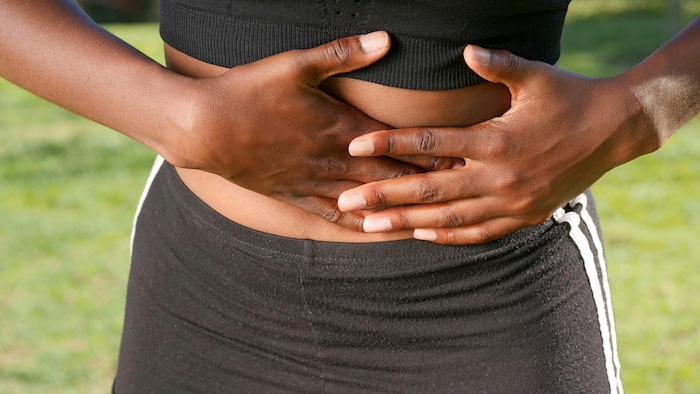
An intercostal muscle strain refers to a muscle injury between two or more ribs. The intercostal muscles, commonly referred to as the intercostals, connect the ribs and help make up the chest wall. When these muscles overstretch or tear, they can cause significant pain in the mid and upper back.
Intercostal muscle strain is a common injury in athletics and hard labor. It is not typically caused by everyday activity. While an intercostal muscle injury can cause intense pain, most cases are fully healed within 6 to 8 weeks.
What Are the Intercostal Muscles?
There are 11 sets of intercostal muscles on each side of the rib cage, and each set is located between adjacent ribs in the upper- and mid-back.
Each set of intercostal muscles consists of the following:
- External intercostal muscles are the outermost intercostals, responsible for expanding the chest during breathing to help inhale air and allow for full, deep breaths. 1 The external intercostals originate at the lower edge of one rib and run diagonally forward to attach to the upper edge of the rib below, and are found in the back, sides, and most of the front of the rib cage.
- Internal intercostal muscles sit directly underneath the external intercostals and help collapse the chest during breathing to exhale air. The intercostal muscle fibers run perpendicular to the external intercostals, moving diagonally from front to back along the ribs, and are found in the entire rib cage.
- Innermost intercostal muscles sit directly underneath and run parallel to the internal intercostal muscles, and run from the back of the rib cage to each side. The intercostal veins, arteries, and nerves are typically found between the internal and innermost intercostal muscles.
In addition to aiding in breathing, the intercostal muscles also help stabilize the rib cage as the upper body twists or bends forward, backward, or to the side. While the intercostal muscles do not connect directly to the spine, their stabilizing role in the rib cage assists in maintaining posture and keeping the back strong and healthy.
Causes of Intercostal Muscle Strain
An intercostal muscle strain can occur from any number of injuries, including:
- A direct blow to the rib cage, such as from a fall or car accident, in which the ribs are forced apart suddenly and the intercostal muscles stretch or tear. Blows that occur from contact sports, such as football or hockey, may cause an intercostal muscle strain from one-time or repeated jolts to the torso.
- Twisting the torso beyond its normal range can pull the ribs farther apart than normal and cause the intercostals to overstretch or tear. Excess twisting may occur from sports such as tennis or golf, or from twisting while lifting. Less forceful twisting can also strain the intercostal muscles, such as in certain yoga postures or dance positions.
- Reaching overhead, as when painting a ceiling or lifting above the shoulders. Prolonged overhead reaching can cause the intercostals to remain extended longer than is typical, putting undue stress on the muscles and causing injury.
- Repetitive, forceful motions, as one might experience during rowing, tennis, batting, or pitching. These motions and repeated stressors can gradually overstretch and tear the intercostal muscles.
- Simply doing the above actions does not always lead to intercostal muscle strain. The likelihood of an intercostal strain increases when the muscles are weakened, either from overusing the muscles to the point of burnout, from atrophy due to lack of exercise, or from chronic poor posture.
Intercostal Muscle Strain Risk Factors
The following activities can also increase the risk of straining an intercostal muscle and causing upper back pain:
- Physical labor, which typically requires many movements that can injure the intercostals, including frequent heavy lifting, repeated bending or reaching, and/or excessive twisting of the torso. Safe lifting techniques are essential for preventing a range of injuries, including intercostal strain.
- Contact sports in which the upper body is hit with sudden, direct force, including but not limited to football, hockey, or rugby.
- High-thrust sports, such as baseball/softball pitching and tennis, in which high force in the arm, shoulder, and upper back muscles is used repeatedly, putting undue pressure on these muscles and increasing the risk for strain. 1 These high-thrust motions may include pitching, batting, or swinging a tennis racket or golf club.
Always take the appropriate precautions before taking part in the above activities, or talk to a doctor before starting a new exercise to lessen the risk of injury.
When to See a Doctor
Some cases of intercostal muscle strain may be so mild that pain or stiffness alleviates within a few days and thus does not necessitate medical attention. It is advisable to see a doctor if upper back pain persists for several days or begins to interfere with daily activity, such as going to work or sleeping.
Additionally, medical attention is advisable if upper back pain is so severe that it causes difficulty breathing or makes everyday movements feel impossible, such as lying down or moving from standing to sitting. Severe pain that occurs following a traumatic injury, such as a fall or car accident, should be promptly addressed by a doctor.
Precision Pain Care and Rehabilitation has two convenient locations in Richmond Hill – Queens, and New Hyde Park – Long Island. Call the Queens office at (718) 215-1888 or (516) 419-4480 for the Long Island office to arrange an appointment with our Interventional Pain Management Specialists, Dr. Jeffrey Chacko or Dr. Sonny Ahluwalia.













